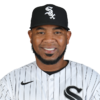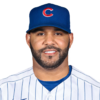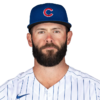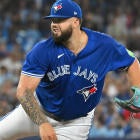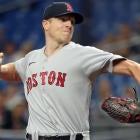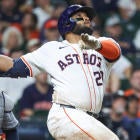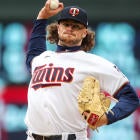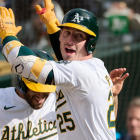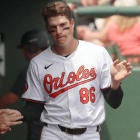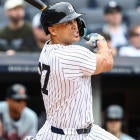On the Fantasy Baseball Today podcast recently, we've had a lot of discussions about whether we play Fantasy baseball "too scared." I'll let listener Kris break it down:
It's so funny that y'all (Scott and Chris) brought up that you'd rather shoot yourselves in the foot with inaction rather than pro-action. I was just talking to my buddy the night before about how y'all play scared. I flat dropped Alex Bregman in a 12-Team Mixed League over three weeks ago, and shake my head every time y'all still bring his name up. Among others, he and Matt Harvey have been sitting on my league's waiver wire for multiple weeks. I'd love to play in the podcast league next year. Maybe I'll bench my entire team during July to give y'all a chance to catch up once your players turn it around.
This has made me think about whether we need to be more proactive about acknowledging potential busts when we come across them. Big-name players typically have varied enough skill sets that even if they fall off, they aren't useless. But there is plenty of value in looking at which slow starts might be for real.
So, that's just what we'll do. I'm going to take a look at players who were drafting in the first three rounds on average (according to FantasyPros.com's ADP), all of whom have been disappointing to some extent through the first two months of the season. We'll look at each player's biggest potential Achilles' heel, and whether it is really something to be concerned about moving forward.
Jose Altuve's strikeout rate
What's wrong?
Altuve isn't striking out at an alarming rate for a normal baseball player, of course. He has just the 127th-highest strikeout rate among 180 qualified batters entering play Thursday, at 16.4 percent. However, it is undeniably a red flag for someone who has never been above 12.6 percent for a full season – in fact, he has never struck out this much over a 46-game stretch in his career.
Is it a concern?
Well, it's going to be hard to hit .340 again if he keeps striking out at this rate, that's for sure. One thing to keep in mind here is that Altuve is being treated like the power threat he now is, with opposing pitchers throwing fastballs to him just 48.2 percent of the time. That is going to naturally lead to more strikeouts, though it's also worth noting his strikeout rate is down to 9.7 percent in the month of May, so it really doesn't seem like anything more than an April outlier.
Josh Donaldson's health
What's wrong?
You probably don't think of him as an older player, but Josh Donaldson is a classic late bloomer who will be 32 after this season. The body just doesn't bounce back the way it used to, and we're seeing that with Donaldson, who hasn't played since April 13 with a calf injury that wasn't initially expected to be a long-term issue.
Is it a concern?
The Blue Jays' patience in bringing Donaldson back could be telling. Maybe they're just expressing an over-abundance of caution with their superstar, or maybe the injury really has taken this long to get healthy. That would be a big red flag, and you have to be worried about both Donaldson's ability to both stay healthy moving forward and his ability to live up to his potential if he does.
Trea Turner's plate discipline
What's wrong?
Even at the best of times last season, Trea Turner was hardly Joey Votto out there. He didn't strike out at an alarming rate, but he also rarely walked, two trends he has taken to more of an extreme to date. Turner has just five walks to 35 strikeouts in 35 games, hardly an ideal ratio for someone whose main job at the plate is to get on base.
Is it a concern?
It's a concern, to be sure, but not one we really need to panic about. Maybe he won't return value on that early-second rounder you invested in him, but Turner still has plenty of better days ahead of him. He is still doing a good job of hitting the ball to all fields, and while he may not get to the .388 BABIP he managed last season, he has plenty of room to grow from his current .288 mark as well. Turner will still be helpful enough in runs, steals and batting average that I think you'll still be viewing him as a third-round pick next offseason.
Edwin Encarnacion's strikeout rate
What's wrong?
After seeing his strikeout rate bump up a bit from 15.7 to 19.7 percent last season, Edwin Encarnacion has really seen it jump this season, with a 28.2 percent mark so far. And, even as he has heated up in May, with five of his nine homers and counting, he is still striking out 22.5 percent of the time.
Is it a concern?
Note, that May mark is an improvement, of course, but it would still be the worst mark of his career. That might be a sign of a loss of bat speed for a 34-year-old, however he does still have a 26.2 percent line drive rate and 42.1 percent hard-hit rate. It's fair to assume Encarnacion has lost something, and he might need to cheat to catch up to fastballs a bit more than in the past. The bar for an elite first baseman is awfully high, and he might not be able to clear it consistently anymore, but I still expect Encarnacion to be a top-10 option moving forward.
Jonathan Villar's missing steals
What's wrong?
There really isn't just one place where Jonathan Villar is disappointing. He's hitting for less power. He's striking out more. He's walking less. But the most glaring one right now has been one that nobody really expected to be an issue for him: Villar isn't running nearly as often. Through 46 games, he has 12 steals in 15 attempts, putting him well behind the pace needed to match last season's 62 steals in 80 attempts.
Is it a concern?
According to Baseball-Reference.com, Villar has run on 23.4 percent of his stolen base opportunities this season, down from 31.7 percent a year ago. Stealing bases is as much about intent as opportunity, and with the Brewers a lot more competitive than last season, they may be less willing to risk outs on the basepaths. Another issue? Villar has been picked off five times, compared to just six times all last season. If you consider those stolen base attempts, he's actually not far off last year's pace, so it could be an easy fix – at least for that one issue.
Jake Arrieta's groundball rate
What's wrong?
Last season, Jake Arrieta's biggest issue was walks as he struggled with his command en route to a 9.6 percent walk rate, his highest since joining the Cubs. That hasn't been an issue this season as he has walked just 6.3 percent of opposing hitters, in line with his best marks. The issue instead has been his ground-ball rate, which has plummeted to 41.3 percent from 52.6 percent a year ago and a high of 56.2 percent in his Cy Young season of 2015.
Is it a concern?
This issue reached a nadir in his first two May starts when he had just 11 groundballs, compared to 22 flyballs in those starts. In two starts since, he has 18 groundballs to 18 flyballs. That isn't the kind of ratio we've gotten use to seeing from him over the years, but it's a big improvement, and with Arrieta talking about mechanical changes he made during his most recent – six innings with no earned runs against the Brewers – it seems like better days should be ahead. I'm not as worried as some in the industry, and still view Arrieta as a top-five starting pitcher – admittedly, with more confidence after his last start.
Trevor Story's strikeout rate
What's wrong?
We knew Trevor Story was going to strike out a lot, given his long swing and patient approach at the plate, but there's a balance to strike. He proved he can be an elite power hitter at 31.3 percent last season, thanks to the BABIP-boosting effects of Coors Field and a favorable batted-ball profile that accentuates his natural raw power. Before the shoulder injury that landed him on the DL, however, Story was striking out at a 36.4 percent rate, which is territory very few players have managed. He wasn't one of them.
Is it a concern?
Obviously, it is worth noting Story also struck out at a 36.3 percent clip last April, and improved from that point on. Of course, he also crushed 10 homers in that month, so it's awfully hard to complain much about that. We know he can succeed that way, but it's far from ideal, especially when Story is hitting three of every five batted balls in the air, negating any gains he may make from Coors' batting average-saving factors. The shoulder issue could have been screwing up his swing – Story did homer Thursday, his second game back in the lineup from the DL – but you can't help but be concerned right now. Story's performance this season is basically one big red flag.













